Xanthomonas Wilt of Banana Drives Changes in Land-Use and Ecosystem Services Across Infected Landscapes
Abstract
1. Introduction
2. Materials and Methods
2.1. Study Area
2.2. Land-Use Trajectories and Food Systems
2.3. Effect of XW Driven Land-Use Trajectories of Change on Selected Supporting and Regulatory Ecosystem Services
2.3.1. Soil Carbon and Nutrients
2.3.2. Soil Erosion Losses
3. Results and Discussion
3.1. On-Farm Coping Strategies Against Xanthomonas Wilt Disease
3.2. Crop Diversification Trajectories Due to Xanthomonas Wilt Disease
3.3. Perceived Changes in The Food Systems Due to XW Stress
3.4. Farmers’ Perceptions on The Future Role of Banana and The Sustainability of The Key Land-Use Trajectories in XW-Affected Landscapes
3.5. Soil Quality
3.6. Soil Erosion Control
4. Conclusions
Author Contributions
Funding
Acknowledgments
Conflicts of Interest
References
- Robinson, J.C.; Saúco, V.G. Bananas and Plantains; CAB International (Cabi): Cambridge, MA, USA, 2010; Volume 19. [Google Scholar]
- FAO. Online Statistical Database. Food and Agriculture Organization of the United Nations. Available online: http://www.fao.org/faostat/en/#data/QC (accessed on 10 September 2018).
- Abele, S.; Twine, E.; Legg, C. Food Security in Eastern Africa and the great lakes. In Crop Crisis Control Project Final Report; International Institute of Tropical Agriculture: Ibadan, Nigeria, 2007. [Google Scholar]
- Karamura, E.B.; Turyagyenda, F.L.; Tinzaara, W.; Blomme, G.; Molina, A.; Markham, R. Xanthomonas wilt (Xanthomonas campestris pv. musacearum) of Bananas in East and Central Africa. In Diagnostic and Management Guide; Fountain Publishers: Kampala, Uganda, 2008. [Google Scholar]
- Okech, H.O.; Gold, C.S.; Abele, S.; Nankinga, C.M.; Wetala, P.M.; van Asten, P.; Nambuye, A.; Ragama, P. Agro nomic, pests and economic factors influencing sustainability of banana-coffee systems of Western Uganda and potentials for improve ment. Uganda J. Agr. Sci. 2004, 9, 432–444. [Google Scholar]
- Edmeades, S.; Smale, M.; Kikulwe, E.M.; Nkuba, J.; Byabachwezi, M.S.R. Characteristics of banana-growing households and banana cultivars in Uganda and Tanzania. In An Economic Assessment of Banana Genetic Improvement and Innovation in the Lake Victoria Region of Uganda and Tanzania; IFPRI Research Report 155; Smale, M., Tushemereirwe, W.K., Eds.; IFPRI: Washington, DC, USA, 2007; pp. 49–74. [Google Scholar]
- Simmonds, N.W. Bananas, 2nd ed.; Longmans: London, UK, 1966. [Google Scholar]
- Simmonds, N.W.; Shepherd, K. The taxonomy and origins of the cultivated bananas. Bot. J. Linn. Soc. 1955, 55, 302–312. [Google Scholar] [CrossRef]
- Bekunda, M. Farmers’ responses to soil fertility decline in banana-based cropping systems of Uganda. Managing Africa’s Soils. 1999. No. 4. Available online: http://pubs.iied.org/pdfs/7397IIED.pdf (accessed on 24 November 2017).
- Gold, C.S.; Karamura, E.B.; Kiggundu, A.; Bagamba, F.; Abera, A.M.K. Geographic shifts in highland cooking banana (Musa spp., group AAA-EA) production in Uganda. Int. J. Sust. Dev. World Ecol. 1999, 6, 45–59. [Google Scholar] [CrossRef]
- Ocimati, W.; Groot, J.C.J.; Tittonell, P.; Taulya, G.; Blomme, G. Effects of Xanthomonas wilt and other banana diseases on ecosystem services in banana-based agroecosystems. Acta Hort. 2018, 1196, 19–32. [Google Scholar] [CrossRef]
- Baragengana, R. Banana production and research in Burundi. In Banana Production and Research in Eastern and Central Africa, Proceedings of the a Regional Workshop held in Bujumbura, Burundi, 14–17 December 1983; IDRC-MR114e; Kirkby, R.A., Ngendayo, D., Eds.; IDRC: Ottawa, Canada, 1985; pp. 23–27. [Google Scholar]
- Rishirumuhirwa, T.; Roose, E. The Contribution of Banana Farming Systems to Sustainable Land Use in Burundi. Adv. GeoEcol. 1998, 31, 1197–1204. [Google Scholar]
- Lufafa, A.; Tenywa, M.M.; Isabirye, M.; Majaliwa, M.J.G.; Woomer, P.L. Prediction of soil erosion in a Lake Victoria basin catchment using a GIS-based Universal Soil Loss Model. Agric. Syst. 2003, 76, 883–894. [Google Scholar] [CrossRef]
- Dayton, P.K. Toward an understanding of community resilience and the potential effects of enrichments to the benthos at McMurdo Sound, Antarctica. In Proceedings of the Colloquium on Conservation Problems in Antarctica; Allen Press: Lawrence, KS, USA, 1972. [Google Scholar]
- Castellani, E. Su un marciume dell’ Ensete. L’Agricoltura Coloniale. Firenze 1939, 33, 297–300. [Google Scholar]
- Tushemereirwe, W.; Kangire, A.; Ssekiwoko, F.; Offord, L.C.; Crozier, J.; Boa, E.; Rutherford, M.; Smith, J.J. First report of Xanthomonas campestris pv. musacearum on banana in Uganda. Plant Pathol. 2004, 53, 802. [Google Scholar] [CrossRef]
- Ndungo, V.; Bakelana, K.; Eden-Green, S.; Blomme, G. An outbreak of banana Xanthomonas wilt (Xanthomonas campestris pv. musacearum) in the Democratic Republic of Congo. InfoMusa 2004, 13, 43–44. [Google Scholar]
- FAO. Banana Production Systems at Risk: Effectively Responding to Banana Wilt Disease in the Great Lakes Region, FAO Banana Factsheet. 2012. Available online: http://www.fao.org/fileadmin/user_upload/emergencies/docs/FAO%20BANANA%20factsheet%20ENGLISH.pdf (accessed on 22 November 2017).
- Desire, R.M.; Bahananga, J.B.M.; Romain, L.; Barhahakana, C.; Amato, S. Analyse de l’impact socioéconomique du flétrissement bactérien du bananier et réponses paysannes dans la région du Bushi Kivu à l’Est de la République Démocratique du Congo. Int. J. Innov. Appl. Stud. 2016, 18, 66. [Google Scholar]
- UNDP. Profil Resume Pauvrete Et Conditions De Vie Des Menages Programme des Nations Unies pour le développement Unité de lutte contre la pauvreté: Province du Sud-Kivu. Bukavu, Democtatic Republic of Congo. 2009. Available online: https://www.cd.undp.org/content/rdc/fr/home/library/poverty/pauvrete-et-condition-de-vie-des-menages11111111.html (accessed on 22 November 2017).
- Farrow, A.; Busingye, L.; Bagenze, P. Characterization of Mandate Areas for the Consortium for Improved Agricultural Livelihoods in Central Africa (CIALCA); CIALCA: Bukavu, Democratic Republic of Congo, 2006; p. 132. [Google Scholar]
- CIALCA. CIALCA Progress Reports 05, Final Report Phase I - CIALCA January 2006–December 2008. 2009. Available online: https://test.cialca.org/wp-content/uploads/2018/06/TechnicalReport6.pdf (accessed on 15 March 2017).
- FEWS NET. DRC Plant Disease Report; FEWS NET: Washington, DC, USA, 2017; Available online: https://fews.net/sites/default/files/documents/reports/FEWS_NET_DRC_Plant_Disease_Study_20170516.pdf (accessed on 20 November 2017).
- de Bie, C.A.J.M. Comparative Performance Analysis of Agro-Ecosystems. Doctoral Thesis, Wageningen University, Wageningen, The Netherlands, 2000. Available online: http://library.wur.nl/WebQuery/wurpubs/fulltext/121245 (accessed on 22 November 2017).
- Cohen, D.; Crabtree, B. Qualitative Research Guidelines Project. 2006. Available online: http://www.qualres.org/HomeSamp-3702.html (accessed on 20 November 2017).
- Bellon, M.R.; Raneri, J. Agricultural Biodiversity Assessment: Four Cell Focus Group Methodology. Bioversity Int. 2014. Available online: https://data.ilri.org/tools/lt/dataset/biogroup (accessed on 20 November 2017).
- Raneri, J.; Turmel, M.; Van Zonneveld, M.; Dzomeku, B.; Termote, C.; Bellon, M.R.; Chandrabalan, D.; Zheng, S.; Ocimati, W.; Attwood, S.; et al. Agrobiodiversity 4-Cell Method: A Rapid System Diagnosis Tool. 2016. Available online: https://cgspace.cgiar.org/bitstream/handle/10568/79396/ABD_%204Cell_Poster%202016%20(2).pdf?sequence=1 (accessed on 15 February 2016).
- Sthapit, B.R.; Rana, R.B.; Subedi, A.; Gyawali, S.; Bajracharya, J.; Chaudhary, P.; Joshi, B.K.; Sthapit, S.; Joshi, K.D.; Upadhyay, M.P. Participatory four cell analysis (FCA) for local crop diversity. In Good Practices: On-farm Management of Agricultural Biodiversity in Nepal; NARC/LI-BIRD/Bioversity International: Kathmandu, Nepal, 2006; p. 260. [Google Scholar]
- VSN International. Genstat for Windows, 16th ed.; VSN International: Hemel Hempstead, UK, 2013; Web page: Genstat.co.uk. [Google Scholar]
- Bommarco, R.; Kleijn, D.; Potts, S.G. Ecological Intensification: Harnessing Ecosystem Services for Food Security. Trends Ecol. Evol. 2013, 28, 230–238. [Google Scholar] [CrossRef] [PubMed]
- Wood, S.; Sebastian, K.; Scherr, S.J. Agroecosystems. International Food Policy Research Institute. Available online: https://www.researchgate.net/profile/Kate_Sebastian2/publication/237596137_Agroecosystems/links/53fb51dd0cf27c365cf09c9c.pdf (accessed on 15 March 2016).
- Gliessman, S.R. Field and Laboratory Investigations in Agroecology, 3rd ed.; CRC Press, Taylor and Francis Group: Boca Raton, FL, USA, 2015. [Google Scholar]
- Mehlich, A. Mehlich-3 soil test extractant: A modification of Mehlich-2 extractant. Commun. Soil Sci. Plant Anal. 1984, 15, 1409–1416. [Google Scholar] [CrossRef]
- Bouyoucos, G.J. Hydrometer method improved for making particle size analysis of soils. Agron. J. 1962, 54, 464–465. [Google Scholar] [CrossRef]
- Renard, K.G.; Foster, G.R.; Weesies, G.A.; McCool, D.K.; Yoder, D.C. Predicting Soil Erosion by Water: A Guide to Conservation Planning with the Revised Universal Soil Loss Equation (RUSLE); United States Department of Agriculture: Washington, DC, USA, 1997; Volume 703. [Google Scholar]
- Wall, G.J.; Coote, D.R.; Pringle, E.A.; Shelton, I.J. RUSLEFAC—Revised Universal Soil Loss Equation for Application in Canada: A Handbook for Estimating Soil Loss from Water Erosion in Canada; Research Branch, Agriculture and Agri-Food Canada: Ottawa, ON, Canada, 2002; p. 117. [Google Scholar]
- Stone, R.P.; Hilborn, D.P. Universal Soil Loss Equation (USLE). OMAFRA Factsheet. 2015; Order No. 12-051, Queen’s Printer for Ontario. Available online: http://www.omafra.gov.on.ca/english/engineer/facts/12-051.htm (accessed on 29 February 2016).
- Vrieling, A.; Sterk, G.; de Jong, S.M. Satellite-based estimation of rainfall erosivity for Africa. J. Hydrol. 2010, 395, 235–241. [Google Scholar] [CrossRef]
- Kassam, A.H.; Van Velthuizen, H.T.; Mitchell, A.J.B.; Fischer, G.W.; Shah, M.M. Agro-ecological Land Resources Assessment for Agricultural Development Planning: A Case Study of Kenya Resources Data Base and Land Productivity, Technical Annex 2. Soil Erosion and Productivity; FAO/IIASA: Rome, Italy, 1992; p. 59. [Google Scholar]
- Beernaert, F.R. Development of a Soil and Terrain Map/Database-Democratic Republic of Congo. 1999. Available online: https://library.wur.nl/isric/fulltext/isricu_t4caadfec_001.pdf (accessed on 10 March 2018).
- Van Engelen, V.; Verdoodt, A.; Dijkshoorn, K.; Van Ranst, E. Soil and Terrain Database of Central Africa - DR Congo, Burundi and Rwanda. SOTERCAF, Version 1.0; ISRIC-UGent-FAO: Burundi and Rwanda, Democratic Republic of Congo, 2006; Available online: https://www.wur.nl/en/Publication-details.htm?publicationId=publication-way-333536303038 (accessed on 10 March 2018).
- Wischmeier, W.H.; Smith, D.D. Predicting Rainfall Erosion Losses. A Guide to Conservation Planning; United States Department of Agriculture, Agricultural Research Service (USDA-ARS) Handbook No. 537; United States Government Printing Office: Washington, DC, USA, 1978.
- Blomme, G.; Jacobsen, K.; Ocimati, W.; Beed, F.; Ntamwira, J.; Sivirihauma, C.; Ssekiwoko, F. Fine-tuning banana Xanthomonas wilt control options over the past decade in East and Central Africa. Eur. J. Plant Pathol. 2014, 139, 271–287. [Google Scholar] [CrossRef]
- Ochola, D.; Jogo, W.; Ocimati, W.; Rietveld, A.; Tinzaara, W.; Karamura, D.A.; Karamura, E.B. Farmers’ awareness and perceived benefits of agro-ecological intensification practices in banana systems in Uganda. Afr. J. Biotechnol. 2013, 12, 4603–4613. [Google Scholar]
- Nkuba, J.; Tinzaara, W.; Night, G.; Niko, N.; Jogo, W.; Ndyetabula, I.; Mukandala, L.; Ndayihazamaso, P.; Niyongere, C.; Gaidashova, S.; et al. Adverse impact of banana Xanthomonas wilt on farmers’ livelihoods in Eastern and Central Africa. Afr. J. Plant Sci. 2015, 9, 279–286. [Google Scholar]
- Kalyebara, M.R.; Ragama, P.E.; Kikulwe, E.; Bagamba, F.; Nankinga, K.C.; Tushemereirwe, W.K. Economic importance of the banana bacterial wilt in Uganda. Afr. Crop Sci. J. 2006, 14, 93–103. [Google Scholar] [CrossRef]
- Vandamme, E. Nutrient deficiencies in soils of Walungu, South Kivu, Democratic Republic of Congo. MSc. Thesis, Katholieke Universiteit Leuven, Leuven, Belgium, 2008. [Google Scholar]
- Nyombi, K.; van Asten, P.J.A.; Corbeels, M.; Taulya, G.; Leffelaar, P.A.; Giller, K.E. Mineral fertilizer response and nutrient use efficiencies of East African highland banana (Musa spp., AAA-EAHB, cv Kisansa). Field Crops Res. 2010, 117, 38–50. [Google Scholar] [CrossRef]
- Bekunda, M.; Woomer, P.L. Organic resource management in banana based cropping systems of the Lake Victoria basin, Uganda. Agri. Ecosyst. Environ. 1996, 59, 171–180. [Google Scholar] [CrossRef]
- Mohamoud, Y.M.; Ewing, L.K. Rainfall interception by corn and soybean residue. Trans. ASAE 1990, 33, 507–0511. [Google Scholar] [CrossRef]
- Howeler, R.H.; Oates, C.G.; Allem, A.C.; Chuzel, G.; Henry, G.; Hershey, C.H.; Müller-Sämann, K.M.; Okogun, A.; Sanginga, N.; Souza, L.D.; et al. Strategic environmental assessment, an assessment of the impact of cassava production and processing on the environment and biodiversity. Proc. Valid. Forum Glob. Cassava Dev. Strategy 2001, 5, 1–137. [Google Scholar]
- Angima, S.D.; Stott, D.E.; O’neill, M.K.; Ong, C.K.; Weesies, G.A. Soil erosion prediction using RUSLE for central Kenyan highland conditions. Agri. Ecosys. Environ. 2003, 97, 295–308. [Google Scholar] [CrossRef]
- Borrelli, P.; Robinson, D.A.; Fleischer, L.R.; Lugato, E.; Ballabio, C.; Alewell, C.; Meusburger, K.; Modugno, S.; Schütt, B.; Ferro, V.; et al. An assessment of the global impact of 21st century land use change on soil erosion. Nat. Commun. 2017, 8, 2013. [Google Scholar] [CrossRef] [PubMed]
- Panagos, P.; Borrelli, P.; Meusburger, K.; Alewell, C.; Lugato, E.; Montanarella, L. Estimating the soil erosion cover-management factor at the European scale. Land Use Policy 2015, 48, 38–50. [Google Scholar] [CrossRef]
- De Taeye, S. Soil Erosion Risk Mapping using RUSLE in Rwanda. Msc. Thesis, 2016. Available online: https://lib.ugent.be/fulltxt/RUG01/002/305/181/RUG01-002305181_2016_0001_AC.pdf/ (accessed on 29 February 2017).
- Karamage, F.; Zhang, C.; Ndayisaba, F.; Shao, H.; Kayiranga, A.; Fang, X.; Nahayo, L.; Nyesheja, E.M.; Tian, G. Extent of cropland and related soil erosion risk in Rwanda. Sustainability 2016, 8, 609. [Google Scholar] [CrossRef]
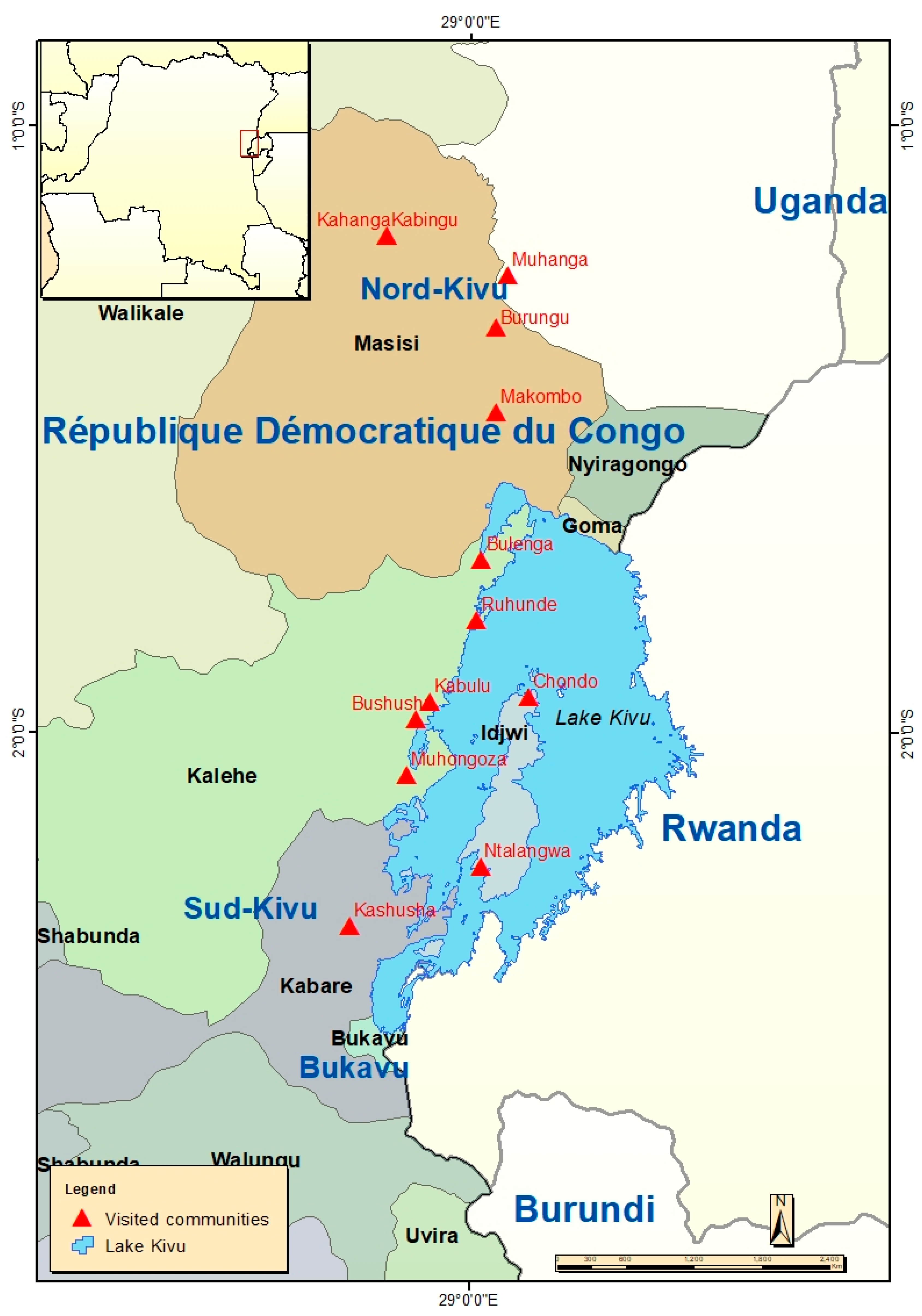
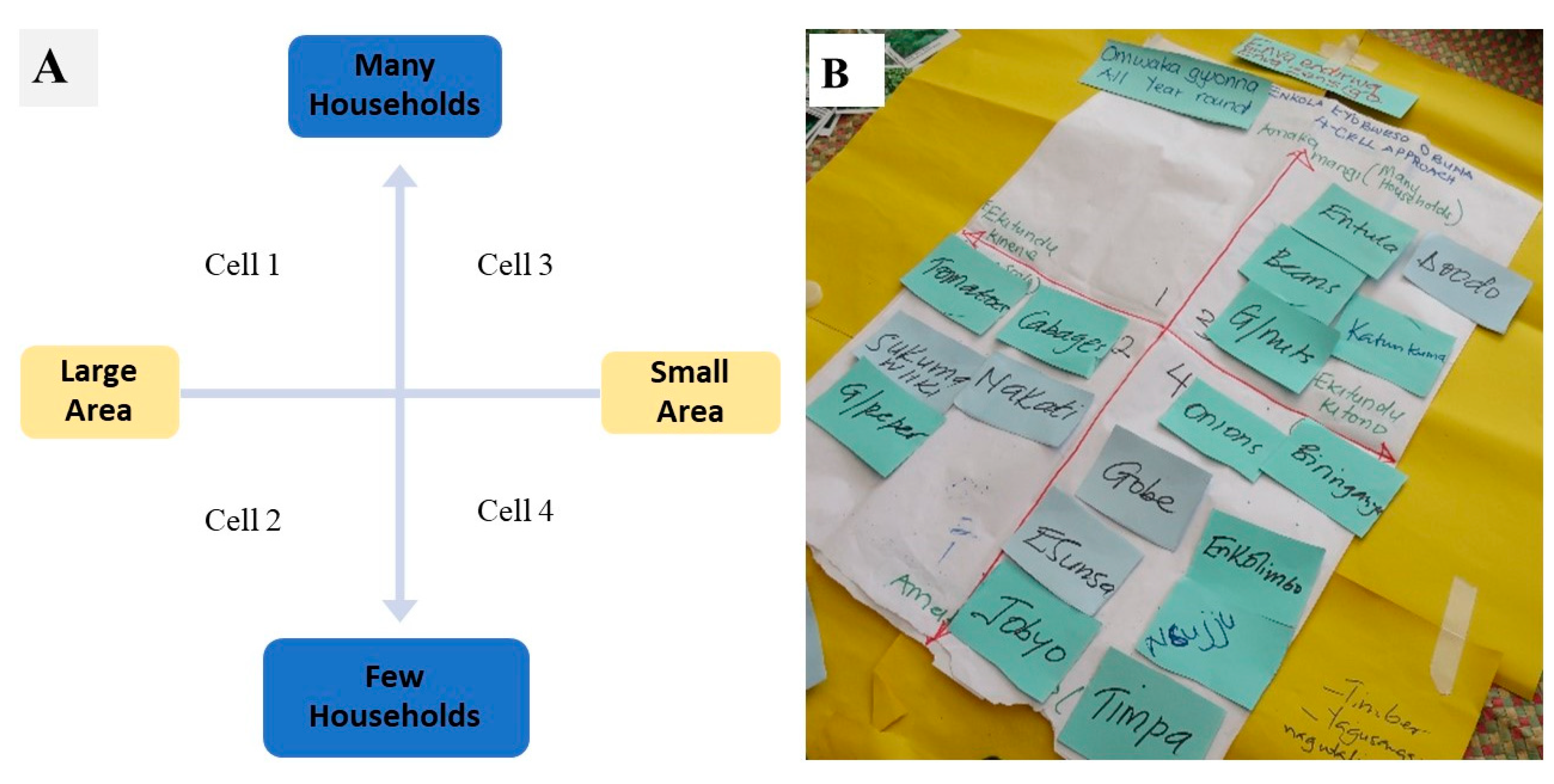
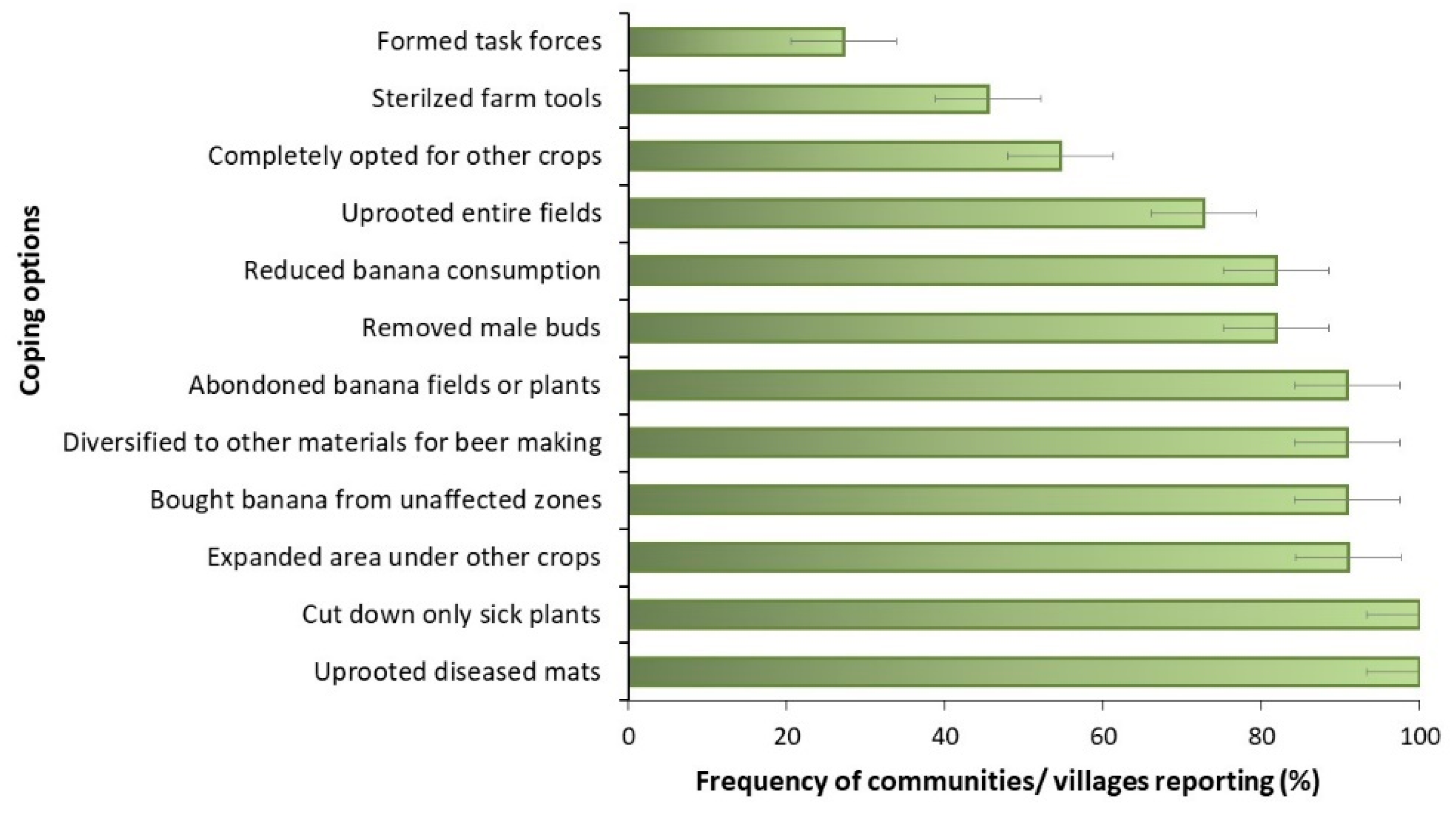

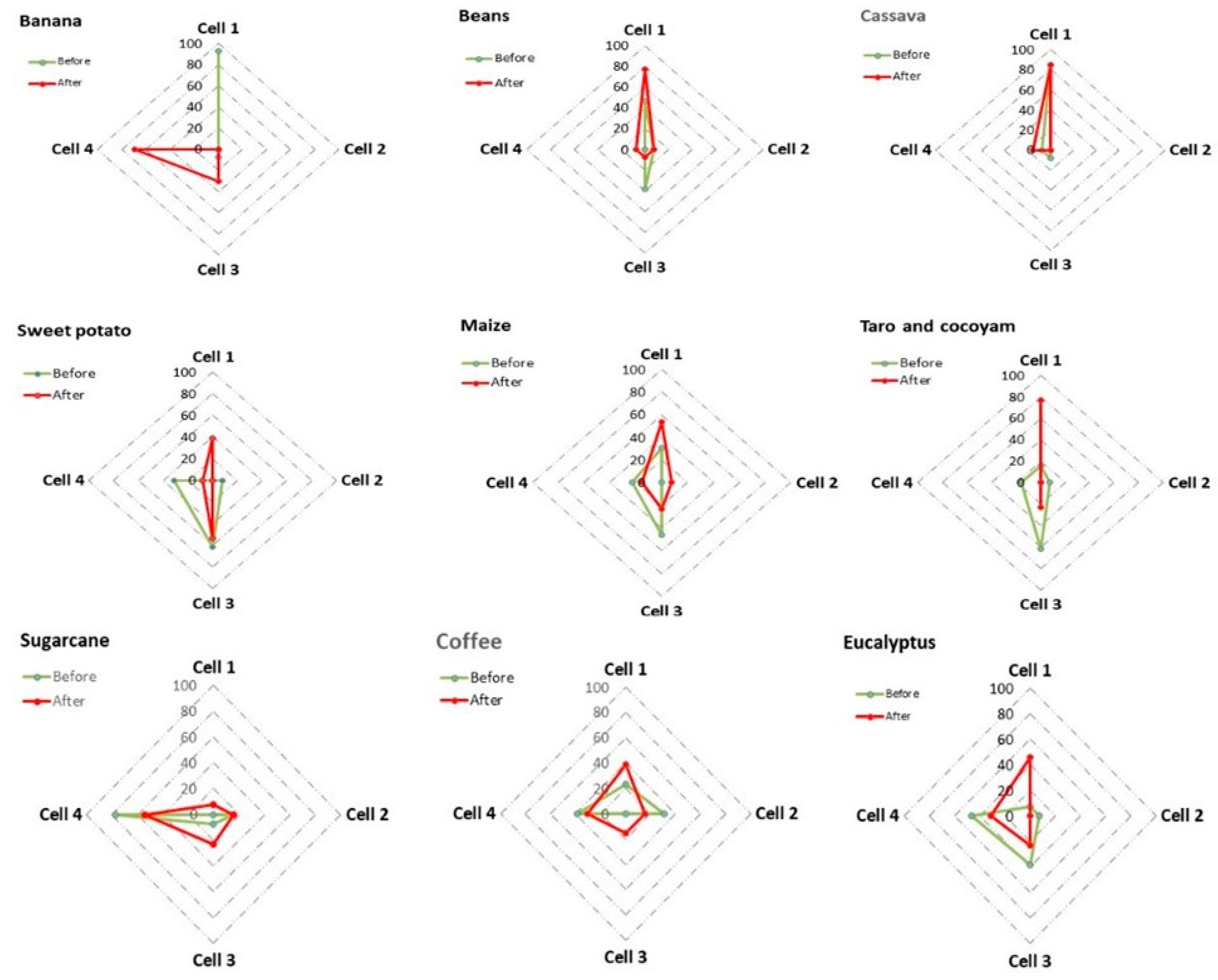
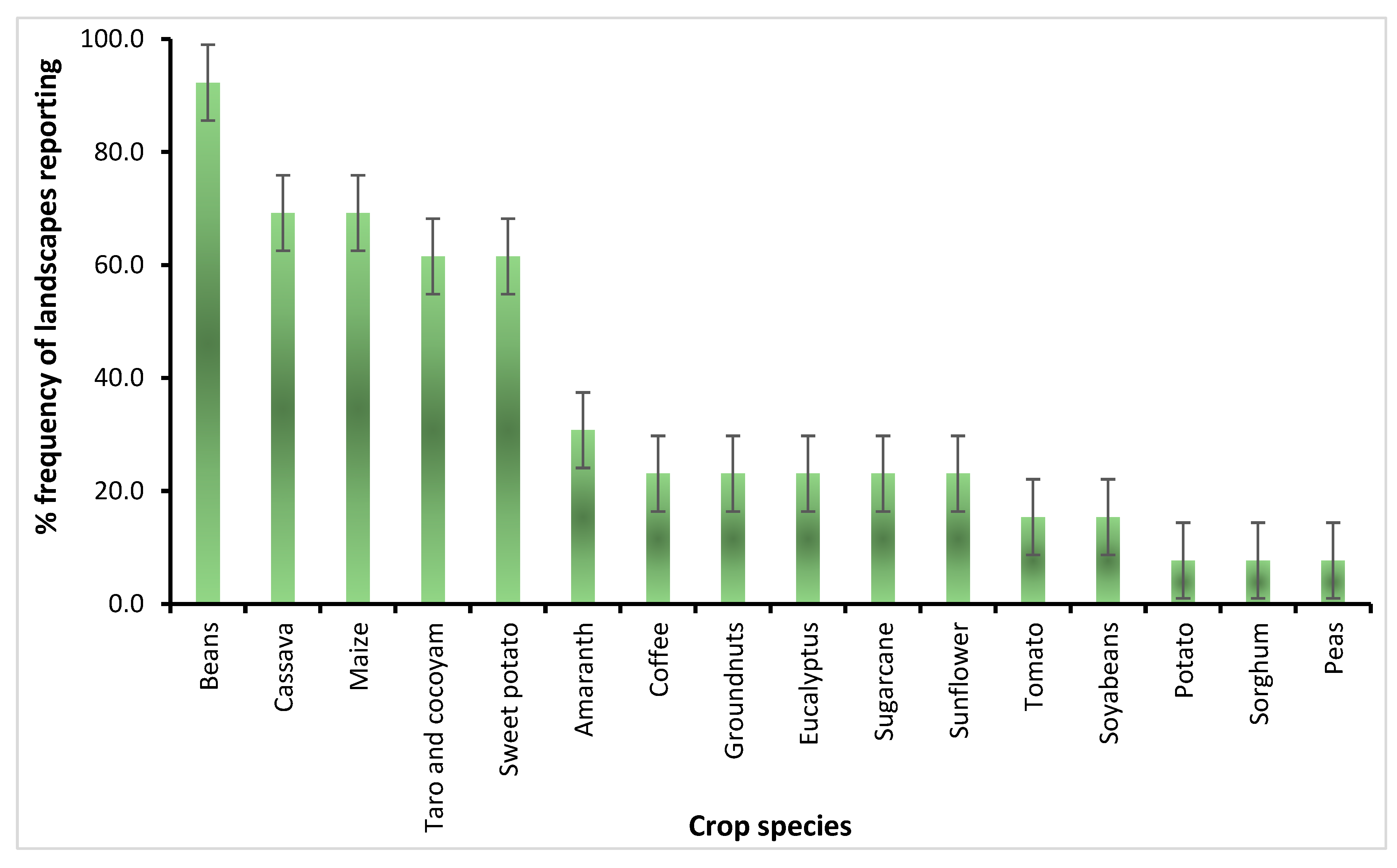
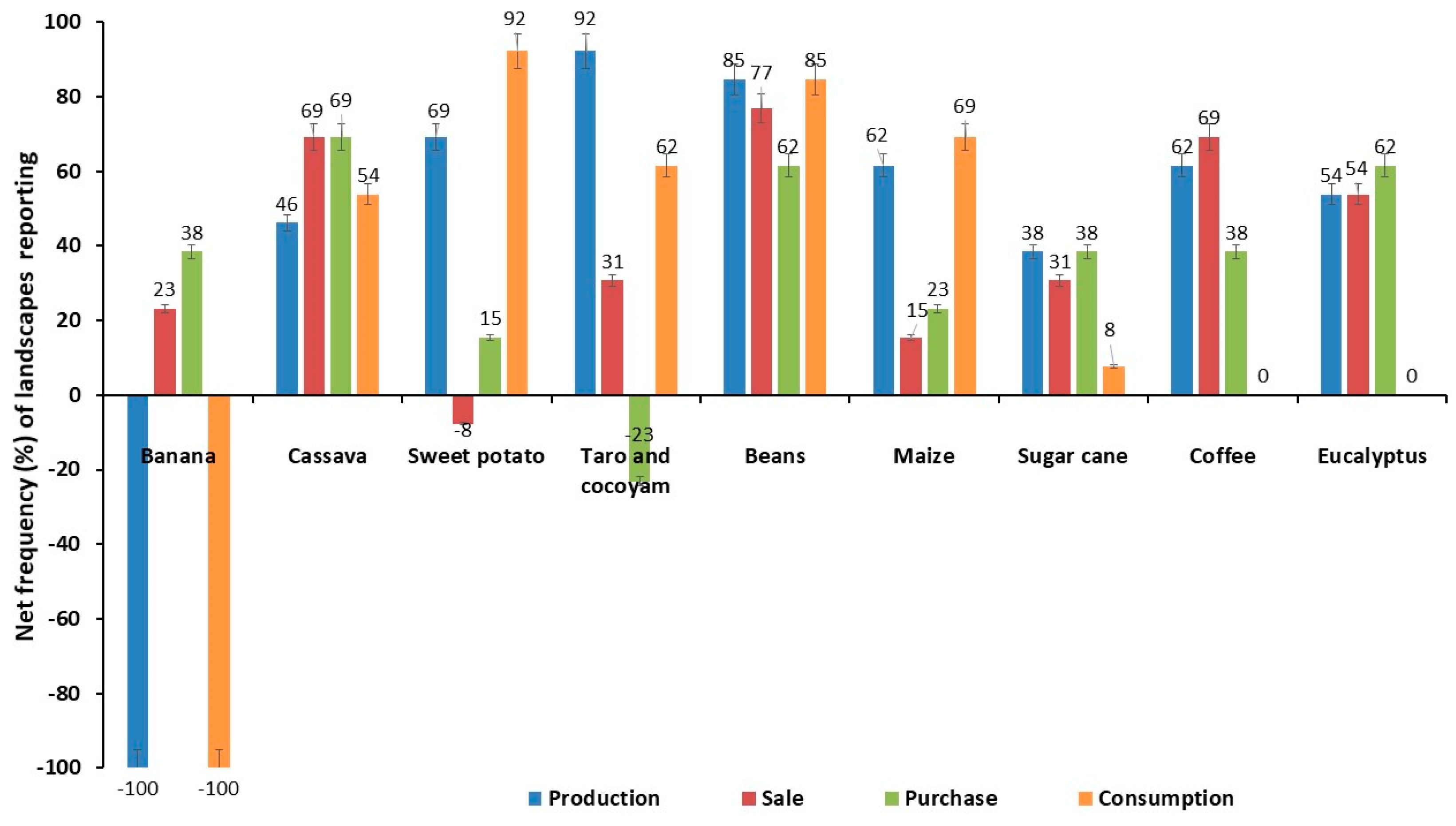
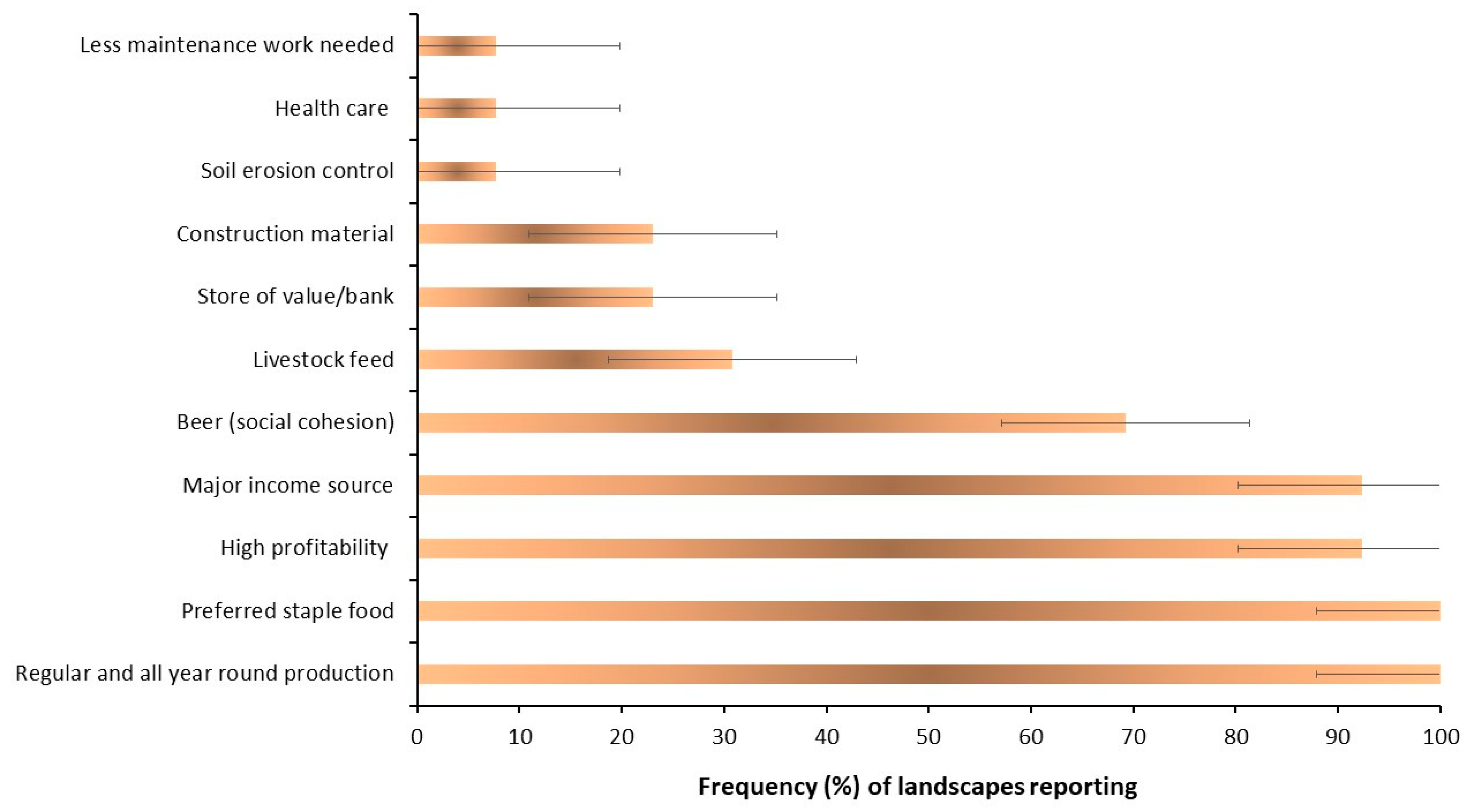
| Province | Territory | Village | Year of XW Outbreak | Longitude | Latitude | Altitude | Distance from Masisi |
|---|---|---|---|---|---|---|---|
| North-Kivu | Masisi | Kahanga-Kabingu | 2004 | - | - | - | 0 |
| Muhanga | 2001 | S01.24778 | E029.05931 | 1701 | 20 | ||
| Burungu | 2004 | - | - | - | 40 | ||
| Makombo | 2008 | S01.47358 | E029.04045 | 2010 | 60 | ||
| South-Kivu | Kalehe | Bulenga | 2005 | S01.71581 | E29.01702 | 1525 | 80 |
| Ruhunde | 2005 | S01.81677 | E029.00951 | 1520 | 100 | ||
| Kabulu | 2005 | S01.94952 | E028.93301 | 1757 | 120 | ||
| Bushushu | 2009 | S01.97875 | E28.90992 | 1486 | 140 | ||
| Muhongoza | 2004 | S02.07115 | E28.89534 | 1585 | 160 | ||
| Kabare | Kahanga | 2009 | S01.18282 | E028.8617 | 1488 | 180 | |
| Kashusha | 2012 | S02.32044 | E28.80240 | 1713 | 210 | ||
| Idjwi | Chondo | 2002 | S01.94219 | E029.09471 | 1550 | - | |
| Ntalangwa | 2008 | S02.22220 | E029.01602 | 1492 | - |
| Soil Chemical Property | Site | Main Plant Cover | LSD | p Values | p Value (Sites) | Cv % | ||||
|---|---|---|---|---|---|---|---|---|---|---|
| Banana | Cassava | Grass | Annual Crops | Trees | ||||||
| Soil Organic Matter | I | 3.96bcd | 3.58def | 3.84cde | 4.16bc | 5.03a | 0.43 | 0.20 | 0.01 | 21 |
| K | 3.49ef | 3.52ef | * | 3.48efg | 3.36fg | |||||
| M | 4.37bf | 3.68cdef | 3.98bcd | 3.048g | 4.22b | |||||
| Mean | 4.04v | 3.61w | * | 3.54w | 4.33v | 0.30 | 0.02 | |||
| Nitrogen (%) | I | 0.30bcd | 0.27de | 0.28cde | 0.30bcd | 0.36a | 0.03 | 0.27 | 0.02 | 18 |
| K | 0.26e | 0.27de | * | 0.26e | 0.26e | |||||
| M | 0.32b | 0.28cde | 0.30bcd | 0.22f | 0.31bc | |||||
| Mean | 0.30v | 0.27w | * | 0.26w | 0.32v | 0.02 | 0.03 | |||
| Phosphorus (ppm) | I | 36.19abc | 14.81d | 3.81d | 20.78bcd | 48.26a | 21.34 | 0.99 | 0.08 | 194 |
| K | 23.93bcd | 8.85d | * | 21.27bcd | 16.07d | |||||
| M | 13.11d | 3.37d | 4.45d | 12.73d | 17.06d | |||||
| Mean | 24.58v | 9.08w | * | 17.81v | 29.03v | 14.4 | 0.10 | |||
| Potassium (cmol(+)/kg soil) | I | 0.21e | 0.19f | 0.14f | 0.13f | 0.19f | 0.10 | 0.07 | <0.001 | 65 |
| K | 0.46ab | 0.31cde | * | 0.36bc | 0.50a | |||||
| M | 0.44ab | 0.15f | 0.16f | 0.15f | 0.23def | |||||
| Mean | 0.36v | 0.20wx | * | 0.19x | 0.27w | 0.07 | <0.001 | |||
| Calcium (cmol(+)/kg soil) | I | 9.02c | 7.22cd | 4.51e | 8.67c | 5.04de | 2.49 | 0.32 | <0.001 | 49.8 |
| K | 15.85b | 15.97b | * | 16.15b | 21.46a | |||||
| M | 9.18c | 4.73de | 4.17e | 8.94c | 3.50e | |||||
| Mean | 10.52v | 8.00w | * | 10.35v | 7.83w | 1.71 | 0.02 | |||
| Magnesium (cmol(+)/kg soil) | I | 4.68de | 4.48de | 2.69g | 5.12d | 2.74g | 1.25 | 0.08 | <0.001 | 43 |
| K | 8.80a | 6.99bc | * | 8.67a | 7.98ab | |||||
| M | 6.57c | 2.97fg | 3.74efg | 4.03def | 3.51efg | |||||
| Mean | 6.35v | 4.38x | * | 5.42w | 4.17x | 0.86 | <0.001 | |||
| Site | Main Plant Cover | Soil Erodibility Factor (K) | Crop Cover | Tillage Method Factor | C Factor | Slope Length (L) | % Slope (S) | LS | P | Amount of Eroded Soil (A) | A for Standardised Mean Slope |
|---|---|---|---|---|---|---|---|---|---|---|---|
| Idjwi | Banana | 0.02684 | 0.12 | 0.43 | 0.048 | 61.1 | 15.6 | 4.61 | 0.43 | 10.7 | 12.74 |
| Cassava | 0.02642 | 0.47 | 0.61 | 0.284 | 48.0 | 19.5 | 5.94 | 0.87 | 148.9 | 141.87 | |
| Grass | 0.02371 | 0.01 | 0.25 | 0.002 | 47.5 | 20.8 | 5.80 | 0.63 | 0.4 | 0.36 | |
| Annual crops | 0.02502 | 0.47 | 0.57 | 0.271 | 42.3 | 9.5 | 1.52 | 0.83 | 28.3 | 55.35 | |
| Trees | 0.02700 | 0.04 | 0.31 | 0.013 | 30.5 | 27.5 | 8.76 | 0.47 | 5.9 | 3.99 | |
| Katana | Banana | 0.00527 | 0.09 | 0.51 | 0.047 | 43.0 | 4.0 | 0.46 | 0.70 | 0.3 | 0.33 |
| Cassava | 0.00527 | 0.41 | 0.53 | 0.213 | 47.4 | 3.9 | 0.45 | 0.92 | 1.7 | 1.93 | |
| Grass | * | * | * | * | * | * | * | * | * | * | |
| Annual crops | 0.00527 | 0.47 | 0.55 | 0.265 | 34.8 | 4.6 | 0.52 | 0.63 | 1.4 | 1.35 | |
| Trees | 0.00527 | 0.04 | 0.50 | 0.018 | 44.6 | 5.2 | 0.69 | 1.00 | 0.3 | 0.26 | |
| Mushinga | Banana | 0.01449 | 0.12 | 0.50 | 0.058 | 48.0 | 10.7 | 2.12 | 0.77 | 5.0 | 8.07 |
| Cassava | 0.01479 | 0.47 | 0.69 | 0.329 | 55.0 | 17.0 | 5.29 | 0.98 | 98.8 | 100.31 | |
| Grass | 0.01449 | 0.02 | 0.25 | 0.005 | 57.9 | 14.0 | 3.47 | 0.25 | 0.4 | 0.49 | |
| Annual crops | 0.01449 | 0.54 | 0.80 | 0.434 | 69.7 | 5.8 | 0.97 | 1.00 | 22.8 | 67.85 | |
| Trees | 0.00527 | 0.02 | 0.29 | 0.006 | 36.8 | 38.8 | 16.31 | 0.28 | 0.4 | 0.18 | |
| LSD | 0.00210 | 0.03 | 0.06 | 0.026 | 15.9 | 6 | 3.24 | 0.15 | 46.5 | - | |
| F pr (Main plant spp.) | <0.001 | <0.001 | <0.001 | <0.001 | 0.396 | <0.001 | <0.001 | <0.001 | <0.001 | - | |
| F pr (Site) | <0.001 | 0.005 | 0.004 | <0.001 | 0.345 | <0.001 | 0.01 | 0.026 | 0.026 | - | |
| Fpr (interaction) | 0.009 | 0.53 | 0.009 | <0.001 | 0.71 | 0.197 | 0.202 | 0.003 | 0.21 | - | |
| Cv% | 23 | 19 | 21 | 30 | 57 | 73 | 135 | 37 | 198 | - | |
© 2020 by the authors. Licensee MDPI, Basel, Switzerland. This article is an open access article distributed under the terms and conditions of the Creative Commons Attribution (CC BY) license (http://creativecommons.org/licenses/by/4.0/).
Share and Cite
Ocimati, W.; Groot, J.J.C.; Tittonell, P.; Taulya, G.; Ntamwira, J.; Amato, S.; Blomme, G. Xanthomonas Wilt of Banana Drives Changes in Land-Use and Ecosystem Services Across Infected Landscapes. Sustainability 2020, 12, 3178. https://doi.org/10.3390/su12083178
Ocimati W, Groot JJC, Tittonell P, Taulya G, Ntamwira J, Amato S, Blomme G. Xanthomonas Wilt of Banana Drives Changes in Land-Use and Ecosystem Services Across Infected Landscapes. Sustainability. 2020; 12(8):3178. https://doi.org/10.3390/su12083178
Chicago/Turabian StyleOcimati, Walter, Jeroen J. C. Groot, Pablo Tittonell, Godfrey Taulya, Jules Ntamwira, Serge Amato, and Guy Blomme. 2020. "Xanthomonas Wilt of Banana Drives Changes in Land-Use and Ecosystem Services Across Infected Landscapes" Sustainability 12, no. 8: 3178. https://doi.org/10.3390/su12083178
APA StyleOcimati, W., Groot, J. J. C., Tittonell, P., Taulya, G., Ntamwira, J., Amato, S., & Blomme, G. (2020). Xanthomonas Wilt of Banana Drives Changes in Land-Use and Ecosystem Services Across Infected Landscapes. Sustainability, 12(8), 3178. https://doi.org/10.3390/su12083178






